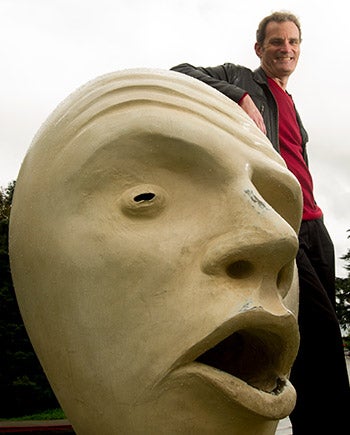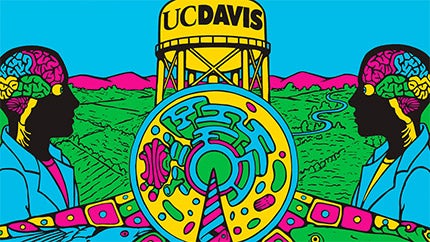It’s the time of year for the end-of-year roundup, so I thought I would make a list of my 10 favorite UC Davis science stories of 2019. But, of course, I am having difficulty keeping it to 10. So here goes:
Good for health ...
FROM THE EGGHEAD BLOG

This article appeared originally on the author’s Egghead blog.
The Department of Radiology took delivery of EXPLORER, a revolutionary new PET (positron emission tomography) scanner that can image the entire human body in a matter of minutes. This reduces radiation exposure and makes it possible to record body processes in real time. EXPLORER was developed by two UC Davis scientists, Simon Cherry and Ramsey Badawi, with financial backing from the National Institutes of Health and is manufactured by United Imaging Healthcare of Shanghai. The machine was due to start scanning patients this winter.
Cannabidiol, or CBD, has been touted as a treatment for all kinds of conditions including anxiety, depression, glaucoma, arthritis and seizures. But sourcing of CBD from hemp plants brings legal and regulatory concerns. UC Davis chemist Mark Mascal showed that a synthetic analogue of CBD, H2CBD, can be used to treat seizures in rats. Unlike plant-based CBD, H2CBD cannot be converted to intoxicating THC. Mascal has founded a company to develop the drug further and hopes to move into clinical trials with colleagues at the UC Davis School of Medicine.
Engineering professor Cristina Davis — again with colleagues at UC Davis Health — came up with a breath test for opioids. You might think of this as an equivalent to an alcohol breathalyzer for law enforcement, but the device could also help doctors monitor opioid levels in patients under their care.
MORE YEAR IN REVIEW

The Zika virus might have receded from the news, but the mosquito-borne virus that causes birth defects if women are infected while pregnant has not gone away. Researchers at the California National Primate Research Center showed that a Zika vaccine protects the fetus in pregnant monkeys, an important step toward approving the vaccine for human use.
And, in “How Come We Didn’t Know That?” news, biomedical engineering graduate student Brent Foster used an MRI to show exactly how wrist bones move in men and women (they are slightly different).
… good for the environment
A lot of the stories we report on the environment are worrying, with the planet apparently on course for rapid climate change. (Check Kat Kerlin’s excellent series “Becoming Arizona” for some local perspective.) So here are a couple of “good news” stories (with the qualifier that, yes, the climate really is changing).
The Bodega Marine Lab’s captive breeding program for white abalone had its most successful spawning season yet, with one female alone producing 20 million eggs. In November, captive-bred abalone were released to the ocean for the first time — in the hope that they will find more of their kind and re-establish a healthy wild population.
VIDEO: SAVING WHITE ABALONE
In another example of a selective breeding program, UC Davis scientists have been raising seedlings from trees that survived the double punch of drought and insect infestation in recent years. They aim to produce trees better adapted to future conditions to help the Sierra forests survive a warming climate.
The Houston Ship Channel is so polluted that the Gulf killifish, a tiny fish that is an important part of coastal food webs, should not be able to survive there. But by a combination of numbers, genetics and good luck the fish has managed to evolve to live with toxic pollutants.
Meanwhile, near Saturn ...

Enceladus is a fascinating little world that has a global ocean of liquid water under an icy crust. And, of course, when we hear about liquid water on moons and planets, we think “Life?!” But the possibility of Enceladanians is not the only interesting thing about this moon of Saturn. It also has weird geological features, including four huge gashes as if it had been clawed by a giant cat. UC Davis planetary scientist Max Rudolph and colleagues at UC Berkeley and the Carnegie Institution now have an explanation for how Enceladus got its stripes. (It does not involve a giant space cat.)
CSI: Protein
DNA sequencing has become an important tool in forensic science as well as anthropology, but DNA isn’t always available or in good condition. Glendon Parker, an adjunct professor of environmental toxicology, is on the trail of another way, by sequencing proteins (which are a lot more durable) and working backward to DNA. This new field of “forensic proteomics” is already helping anthropologists determine the biological sex of human remains from a single tooth.
Still on the detection beat, Mark Statham at the School of Veterinary Medicine is working with the Bureau of Land Management, U.S. Geological Survey and the nonprofit Working Dogs for Conservation to use trained dogs to track down the feces of rare reptiles, to sample their DNA and identify species. It’s a valuable way to survey endangered lizards, Statham said.
Speaking of sniffing things out …
Cats, like many other mammals, have anal glands that produce chemicals they use for scent marking. David Coil and colleagues at the Genome Center studied the microbes from the anal glands of a domestic Bengal cat, and found that the scent-marking chemicals were actually made by microbes, not by the cat itself. In this they had some help from Cristina Davis’ lab (see opioid breath test above), who analyzed whiffs from cultures of these bacteria. The study needs to be expanded to more animals, but it could be an important example of a mutually beneficial relationship between bacteria (which get a place to live) and mammals (which get some chemicals for communication).
Bacteria — this time specially engineered — could also help future robots sense their environment. UC Davis engineer Cheemeng Tan and colleagues at Carnegie Mellon University demonstrated the concept with a robotic arm that can “taste” for a particular chemical before deciding to place an object in a water bath. It’s an example of “soft robotics” where biological, mechanical and electronic systems come together to build robots that can sense and respond to their environment, Tan said.
Platypus yes, tripods no
Paleontology gives us a window into the deep past of our planet, when the Earth was a very different place. One of the interesting things about this is that similar patterns come up again and again — evolution does not mind trying the same solution more than once. For example, Ryosuke Motani and Chinese colleagues described a 250 million-year-old fossil reptile with paddle limbs, a small head and tiny eyes and apparently a wide, cartilaginous bill — very much like (although completely unrelated to) the model duck-billed platypus. Like the modern platypus, the reptile Eretmorhipis carrolldongi likely foraged around in dark, muddy waters, feeling for prey with a soft but sensitive bill.
On the other hand, there are some ideas that evolution has never tried — sometimes called “forbidden phenotypes.” One of these is a true triped, an animal that moves on three legs. Graduate student Tracy Thomson reviewed the record for Bioessays, pointing out there are no known animals, living or extinct, that consistently move or moved on three legs — although there are a handful of examples that come close (such as parrots that use both feet and their beak to climb around in trees).
So that’s my very incomplete and personal list for the year. Have another favorite? Share it on Twitter and tag @UCDavis_Egghead. Happy New Year!